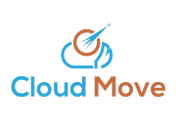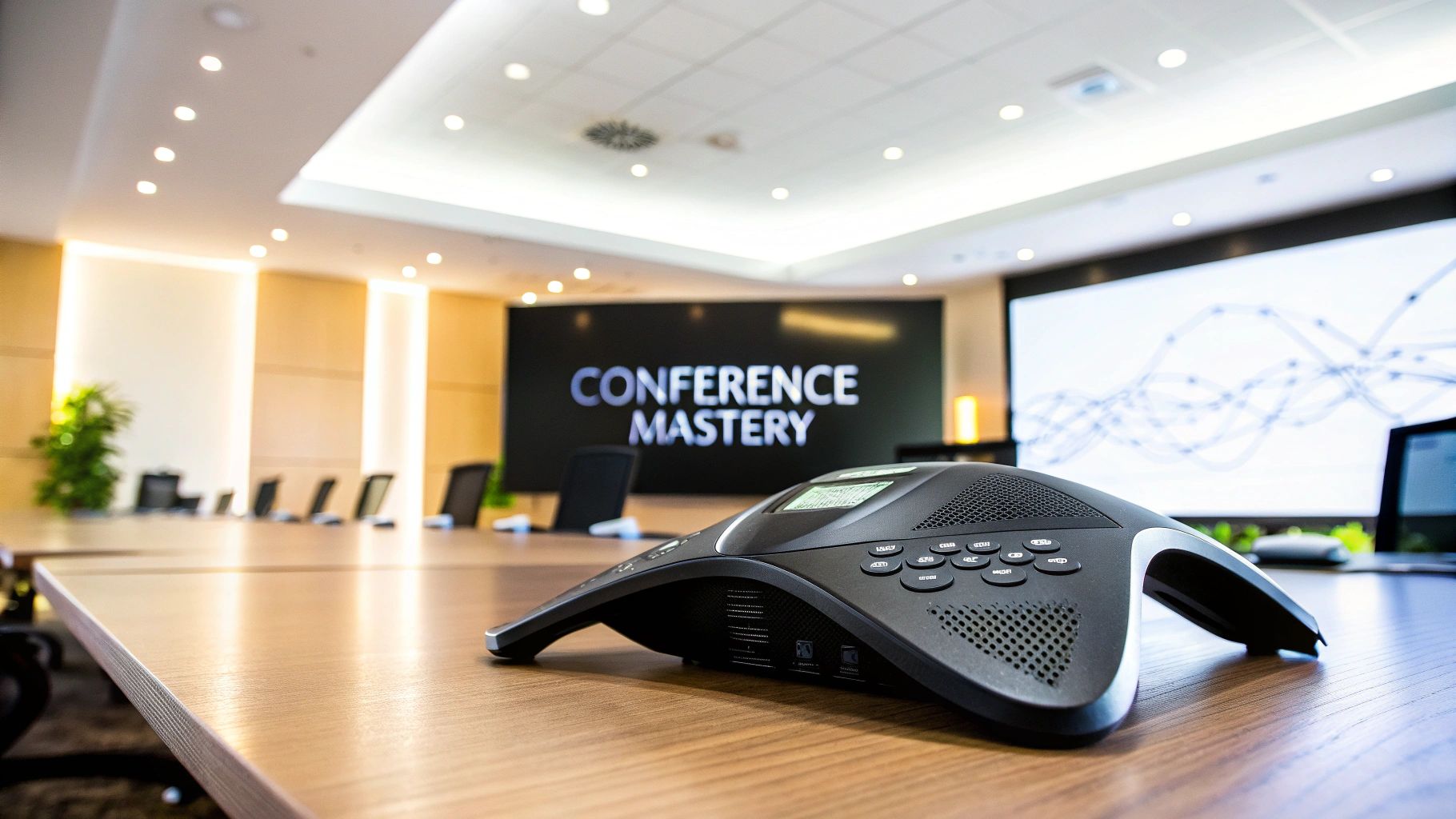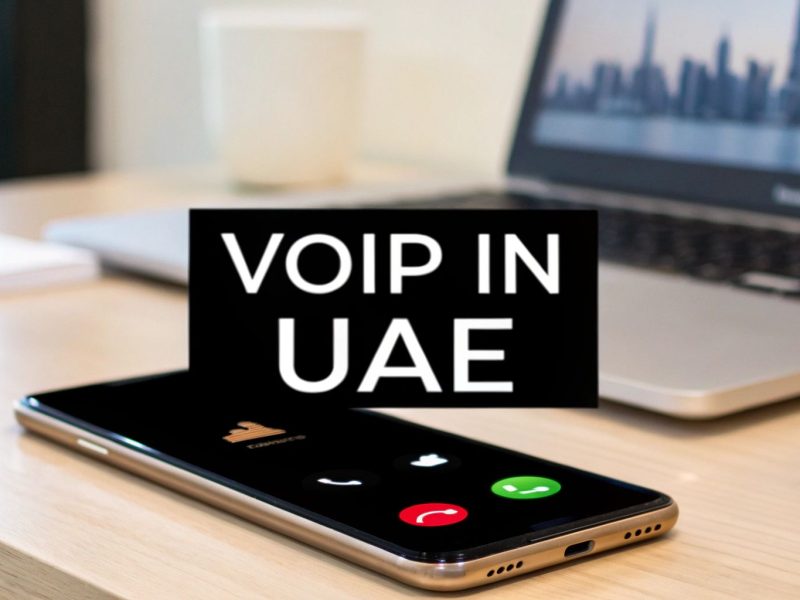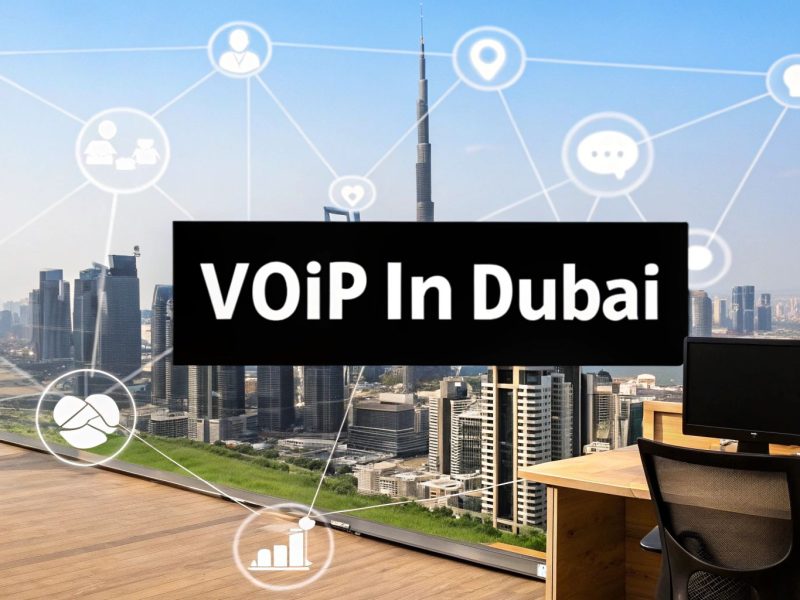When you hear "conference call," what comes to mind? For many, it's the clunky, star-shaped speakerphone sitting in the middle of a boardroom table, often plagued with spotty audio and "can you hear me now?" moments. But the conference phone call of today is a different beast entirely. It's less of a simple phone call and more of a dynamic, interactive hub for getting real work done.
The Evolution of the Conference Phone Call
The old-school conference call was purely an audio affair. It served a basic purpose—connecting multiple voices—but that's where its utility ended. It was often limited by poor sound quality, the inability to share visuals, and a complete lack of interactive features.
Fast forward to today, and a modern conference phone call is an integrated experience. It seamlessly blends crystal-clear voice with high-definition video and instant data sharing. This isn't just an incremental improvement; it's a fundamental shift that turns a static audio link into a rich, virtual meeting room.
The technology driving this change is primarily Voice over Internet Protocol (VoIP), which sends voice and video data over the internet instead of traditional phone lines. To really appreciate how we got here, it’s helpful to understand the broader advantages of VOIP systems for business communication. Another key piece of the puzzle is SIP (Session Initiation Protocol), which you can learn more about by reading our guide on SIP's role in modern communications.
The real magic of the modern conference call is its power to erase physical distance. It makes collaboration feel natural and effective, turning a group of remote individuals into a cohesive team that can see, hear, and work together in real-time.
To really see the difference, let’s compare the old with the new.
Traditional vs Modern Conference Calls
The table below breaks down the key distinctions between the conference calls of yesterday and the powerful solutions available today.
| Feature | Traditional Conference Call | Modern Conference Call |
|---|---|---|
| Technology | Analog phone lines (PSTN) | Internet-based (VoIP/SIP) |
| Media | Audio-only | Audio, HD video, screen sharing |
| Quality | Often low-fidelity, prone to static | Crystal-clear HD audio and video |
| Accessibility | Required dial-in numbers, PINs | Join via link, app, or browser |
| Interactivity | Limited to voice | Chat, polling, whiteboarding, file sharing |
| Cost | Per-minute charges, hardware costs | Flat monthly fees, often software-based |
| Integration | Standalone service | Integrates with calendars, CRM, etc. |
As you can see, the leap is significant. Modern systems provide a richer, more reliable, and cost-effective way to connect.
This infographic further illustrates how modern systems deliver a superior experience.

The data speaks for itself—today's platforms offer far better quality and scalability, all while being more budget-friendly.
This isn't just a trend in one part of a world; it’s a global shift with impressive regional momentum. The video conferencing market in the Middle East and Africa, valued at US$ 619.5 million in 2019, is on track to exceed US$ 1.18 billion by 2027. Countries like the UAE and Saudi Arabia are at the forefront, embracing this technology to power their growing economies.
Features That Define a Superior Experience

Let’s be honest, not all conference calls are the same. We’ve all been on those frustrating calls where you can barely make out what’s being said. While basic audio is the bare minimum, the real magic happens in the features built around that connection. The right tools can elevate a simple phone call into a genuinely productive working session.
Think of it like this: any car can get you from point A to point B, but the experience is defined by the extras. It’s the responsive steering, smooth suspension, and intuitive controls that make the drive enjoyable and effective. The same principle applies here—advanced features deliver the clarity and efficiency that a simple voice-only connection just can't match.
Crystal-Clear Communication
The absolute bedrock of any good meeting is audio quality. If people are constantly asking, "Can you repeat that?" or struggling to decipher muffled voices, productivity grinds to a halt.
- High-Definition (HD) Audio: This should be non-negotiable. HD audio captures a much wider range of sound frequencies than a standard phone line, making conversations sound richer and more lifelike. It’s easier on the ears and helps you pick up on the subtle vocal cues that are often lost.
- AI-Powered Noise Cancellation: A barking dog, a loud coworker, or even just aggressive typing can completely derail a conversation. Modern systems use smart technology to pinpoint and filter out that distracting background noise, keeping the focus squarely on the person speaking.
When every word comes through clearly, you’ve cleared the first and most important hurdle to a successful call.
A superior conference phone call experience isn't just about hearing what is said; it's about understanding the nuance and intent behind the words. High-quality audio and video remove the barriers that cause miscommunication, fostering better alignment and quicker decisions.
Visual and Interactive Collaboration
We’re visual creatures. In business, seeing what someone is talking about isn't just a bonus—it's often essential for true understanding. It's a well-known fact that 90% of information transmitted to the brain is visual, so integrating video and other visual aids is a game-changer.
One of the most powerful tools for this is screen sharing. Instead of trying to awkwardly describe a spreadsheet or a design mockup, you can just show it. This is perfect for walking a client through a proposal, debugging software with a teammate, or reviewing project timelines. It gets everyone on the same page, literally.
Tools for Efficiency and Accountability
A great platform doesn't just stop when the call ends. It should provide tools that keep the momentum going, creating a clear record of what was discussed and decided. This is how you drive real accountability.
- Call Recording: With a single click, you can record the entire meeting. This is a lifesaver for team members who couldn't make it, for reviewing critical decisions before acting on them, or even for creating training materials.
- Automated Transcriptions: Taking it a step further, AI can generate a complete text transcript of the call. Imagine being able to search the conversation for a specific keyword or pull an exact quote without having to re-listen to the whole thing. It turns a one-hour meeting into a searchable document, saving you a ton of time.
These features work together to support the entire lifecycle of a meeting, from the moment you connect to the follow-up tasks that come after.
How to Host Your First Professional Call
Feeling a bit nervous about setting up that first big conference call? Don't be. Honestly, once you break it down, hosting a flawless, professional meeting is much simpler than it seems, even if the tech is new to you. The secret is just taking it one step at a time.
First, let's figure out what you actually need. Is this a quick audio-only chat with a couple of colleagues, or do you need the whole setup—video, screen sharing, and maybe even a recording? The answer will point you toward the right platform. While free tools are out there, a dedicated business solution usually delivers the reliability, security, and quality needed for a truly professional call.
Once you’ve picked your platform, it’s time to get it on the calendar. Scheduling isn't just about finding an open slot; it's your first chance to set the right tone and make sure everyone shows up ready. A great invitation is the key to a smooth start.
The Anatomy of a Perfect Invitation
A good invitation leaves no room for confusion. It should clearly spell out the purpose of the meeting and give everyone what they need to join without any frantic last-minute emails.
- Clear Subject Line: Make it easy to find. Something like "Marketing Strategy Meeting – 25 October" works perfectly.
- A Concise Agenda: Outline 3-5 key discussion points. This helps people prepare and keeps the conversation focused.
- Direct Joining Instructions: Include a simple, clickable link. If there are dial-in numbers or meeting IDs, list them clearly.
- Contact Information: Add a name and number for someone to call if they run into technical trouble.
A well-prepared agenda isn't just a list of topics; it's a roadmap for your conversation. It tells everyone where you're going, what to expect along the way, and what the destination—the meeting's goal—looks like.
Finally, do a quick pre-flight check to eliminate any day-of stress. Hop on 10-15 minutes before the call is set to start and test your microphone, camera, and internet connection. This one simple habit prevents the vast majority of technical glitches that can derail a meeting. For more great advice, you can find helpful tips for mastering Zoom meetings and similar platforms.
By following these fundamentals—choosing the right tool, sending a clear invitation, and doing a quick tech check—you’re setting the stage for a productive and stress-free conference call that gets the job done.
7 Tips for a Flawless Conference Call Experience
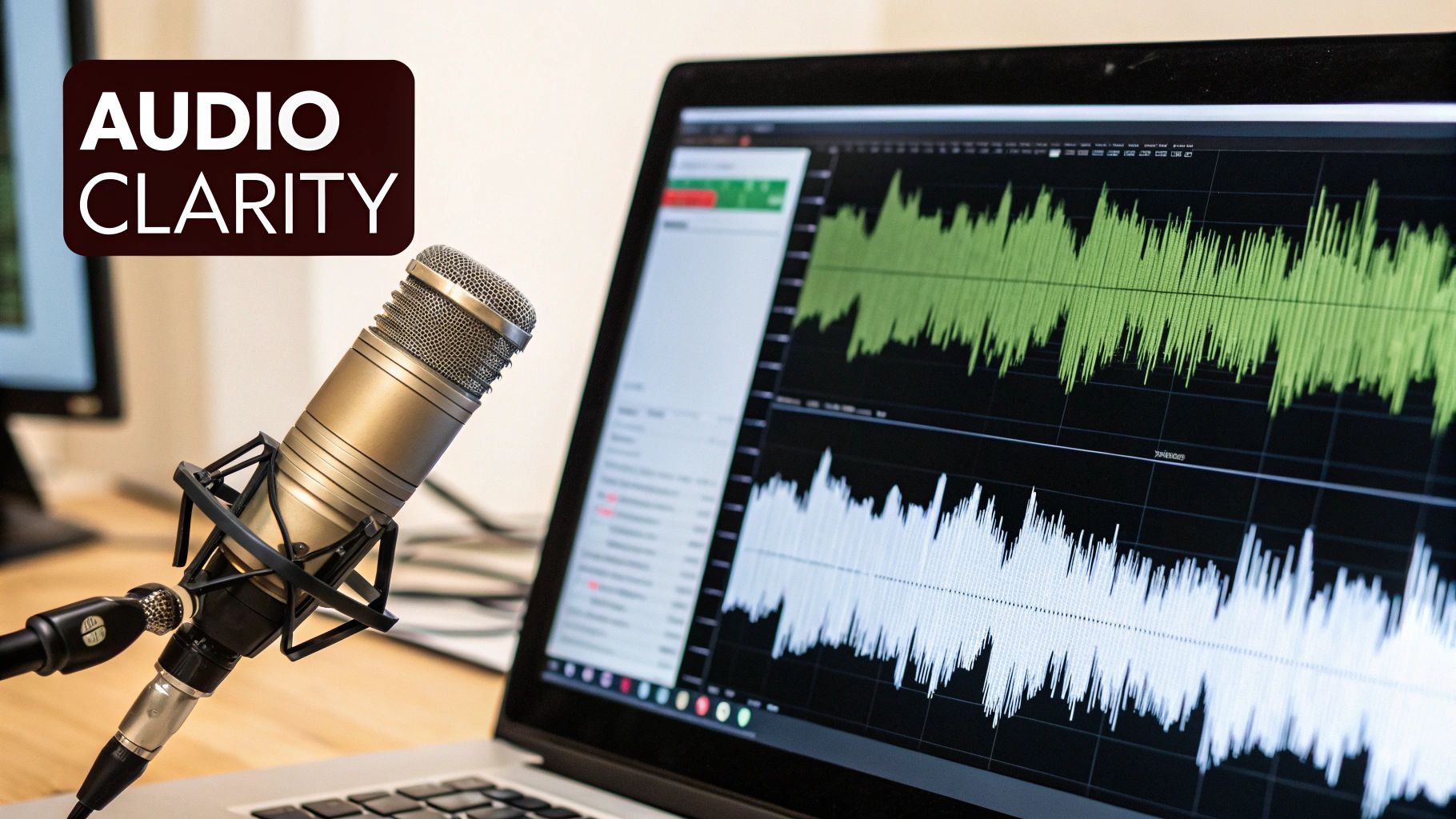
Even with the best technology at your fingertips, the success of a conference call often hinges on the human element. A great meeting isn't just about clear audio; it's about clear communication, which requires a shared understanding of etiquette. Without a few ground rules, a promising discussion can quickly devolve into a confusing, unproductive mess.
Think of it this way: the technology is the stage, but the participants are the actors. Good etiquette is the script everyone follows to ensure the performance is a hit. The goal is to make the tech feel invisible so the conversation can take center stage. This focus on clear communication is a core skill in many professional roles, something we explore in our guide on the essential duties of call center agents.
The Power of a Designated Host
One of the most effective ways to keep a call on track is to appoint a designated host or facilitator. This person doesn't have to be the team leader or the highest-ranking attendee. Their job is simply to steer the ship: stick to the agenda, watch the clock, and create opportunities for everyone to contribute.
A great facilitator is like a conductor leading an orchestra. They don't play every instrument, but they ensure everyone comes in at the right time, creating a symphony of ideas instead of just noise.
This role is crucial for preventing one or two dominant voices from monopolizing the conversation. The host can gently redirect tangents and make a point to invite quieter team members to share their thoughts, leading to a much richer and more balanced discussion.
Mastering Your Virtual Space
Your personal environment directly impacts the entire group's experience. Two simple habits can make a world of difference in maintaining a professional atmosphere.
-
Rule #1: Mute is Your Best Friend. When you're not speaking, hit that mute button. This is non-negotiable. It prevents your background noise—be it a barking dog, a clattering keyboard, or a nearby siren—from derailing the conversation for everyone else.
-
Rule #2: Establish Speaking Order. To avoid the awkwardness of people talking over each other, set a clear protocol. This could be as simple as using the "raise hand" feature in your conferencing software or stating your name before you begin speaking. It keeps the dialogue clean and respectful.
For video calls, a little preparation goes a long way. Make sure your face is well-lit and that your background is tidy and professional. These small touches show you respect your colleagues' time and are fully present in the meeting.
To make things even clearer, here’s a quick rundown of some essential do's and don'ts for your next conference call.
Conference Call Do's and Don'ts
| Do | Don't |
|---|---|
| Test your tech before the call starts. | Join late without a valid reason. |
| Mute your microphone when you aren't talking. | Multitask or get distracted by other work. |
| State your name before you speak. | Interrupt or talk over other participants. |
| Stick to the agenda and stay on topic. | Eat or chew loudly near the microphone. |
| Speak clearly and at a moderate pace. | Forget to turn off notifications on your devices. |
Following these simple guidelines helps ensure that every conference call is a productive and positive experience for everyone involved.
Elevating Calls with Enterprise Cloud Solutions
While basic tools can get you through a simple conference phone call, businesses in dynamic markets like the UAE quickly find they need more. Standard solutions often buckle under the pressure of rapid growth, complex security requirements, and the need for deep integration with other business tools. This is precisely where enterprise-grade platforms like Cloud Move change the game.
These advanced systems are engineered from the ground up for high-stakes business environments. Think of it like the difference between a family sedan and an armored vehicle. Both will get you from A to B, but only one is built to handle mission-critical scenarios with absolute reliability, power, and security.
At their core, enterprise solutions are built on a foundation of superior performance and unwavering dependability.
Unmatched Scalability and Local Performance
One of the biggest advantages of an enterprise platform is its ability to scale effortlessly. A communication system for a growing business has to do more than just work; it must expand from a small team to hundreds of users across multiple offices without a single dropped call or dip in quality. Platforms like Cloud Move are designed for this exact purpose, giving you the agility to add or remove users as your business needs shift.
This kind of scalability is only possible with a solid local infrastructure to back it up. By partnering with leading regional providers like Etisalat and du and using Microsoft Azure data centers, we ensure every call connects with crystal-clear stability. For any business in the UAE, this is vital for seamless regional operations and clear international conversations.
This local focus is becoming more important every day. The Middle East and Africa video conferencing market was valued at USD 83 million in 2024 and is expected to grow at a 13% CAGR through 2031, fueled by the UAE's economic initiatives. You can dive deeper into these market trends in a detailed report.
For an enterprise, a conference call isn't just a conversation; it's a strategic interaction. An enterprise solution transforms this interaction into a secure, documented, and data-rich asset that drives business decisions.
Turning Communication into a Strategic Asset
The real power of an enterprise solution comes from its ability to turn raw communication data into actionable business intelligence. It’s not just about what was said on the call, but what that information reveals about your operations, your team, and your customers.
- Advanced Analytics: Move past simple call logs. You can track meaningful performance indicators, analyze calling patterns, and get a clear picture of team productivity and customer engagement.
- Robust Compliance: In regulated industries like finance and healthcare, compliance isn't optional. Enterprise systems provide features like secure, tamper-proof call recording and strict data protocols that align with local regulations.
- Deep CRM Integration: Your conference call system shouldn't be an island. By integrating directly with CRMs like Salesforce and Microsoft Dynamics, every call automatically enriches your customer profiles, creating a single, unified view of every interaction.
This deep integration is a cornerstone of modern customer service. As companies adopt more ways to connect, understanding the impact of using omnichannels in contemporary call centres is essential for a seamless customer journey. With dedicated support and features built for your needs, an enterprise platform transforms communication from a simple utility into a powerful engine for business growth.
Solving Common Conference Call Problems
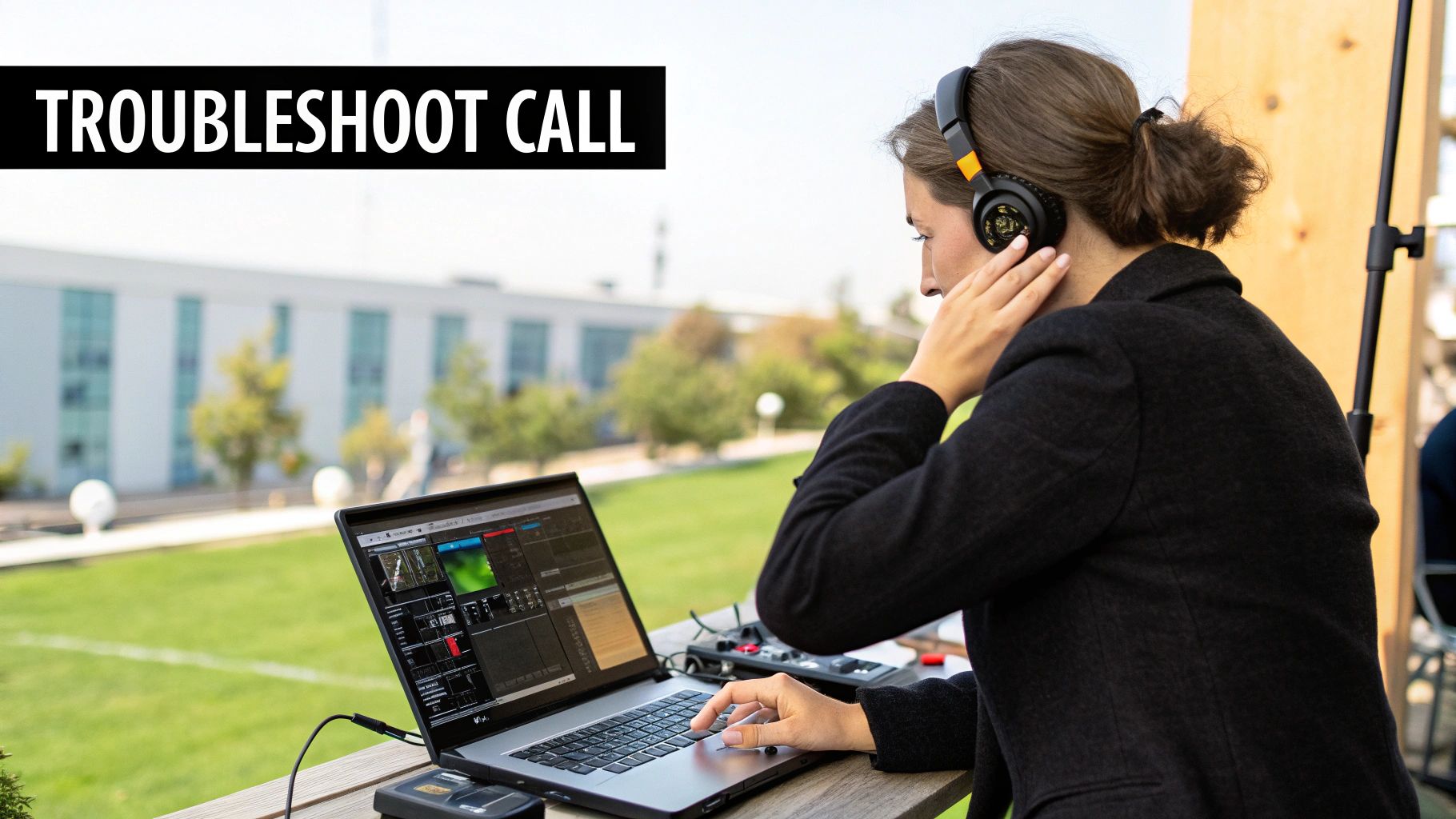
We’ve all been there. The meeting is just getting started, the agenda is packed, and suddenly someone’s audio starts to echo, or a key person can’t connect. Technical glitches are frustrating, but they don’t have to derail your entire conversation.
The trick is knowing how to troubleshoot the most common conference call issues quickly and without panic. Think of it like a first-aid kit for your meetings. A few simple checks can usually fix the problem in moments, getting everyone back to business. Let's look at the usual suspects and how to handle them.
Fixing Poor Audio and Video Quality
By far the most frequent issue is choppy audio or a frozen video feed. When a voice turns robotic or a screen locks up, your first thought should be the internet connection. It’s almost always the culprit.
Before you start rebooting routers, try the simplest fix first: close everything you don't need. That video streaming in another tab? The massive file downloading in the background? All those extra applications are hogging your bandwidth, leaving little for your call. Shutting them down can make an immediate difference.
When a conference call starts to lag, don’t immediately blame the platform. In most cases, the problem lies with local factors like bandwidth or background applications. A quick local check is the fastest path to a clear connection.
If you have the option, plug directly into your router with an Ethernet cable. A wired connection is rock-solid compared to Wi-Fi, which can be unstable and prone to interference from other devices.
Resolving Connection and Noise Issues
What about when someone can't get into the meeting at all? The first step is to have them calmly double-check the essentials: the meeting link and any access codes. A simple typo is a surprisingly common reason for connection failure. If that doesn't work, suggest they try a different web browser or even their phone to see if the issue is with their primary device.
Background noise is another classic meeting-wrecker. That annoying echo you hear is usually caused by someone's microphone picking up the audio from their own speakers, creating a feedback loop.
The solution is simple: politely ask everyone to mute themselves when not speaking. Using headphones is even better. This one small change in etiquette can instantly solve most echo and feedback issues, keeping your conference phone call professional and distraction-free.
Have Questions? We Have Answers.
It’s only natural to have a few questions when you’re looking to upgrade your team's communication tools. Let's tackle some of the most common ones we hear from businesses just like yours.
Are My Conversations on the Cloud Really Secure?
Yes, absolutely. Think of it this way: leading enterprise platforms wrap your conversations in end-to-end encryption, which is the same security standard your bank uses to protect financial data. It's designed to keep your calls private and prevent anyone from listening in.
For businesses here in the UAE, we at Cloud Move take it a step further. By storing all your call data in premier local data centers, we ensure everything stays compliant with regional data sovereignty laws. This means your sensitive information is not only secure but also fully aligned with local regulations.
True security is about more than just preventing eavesdropping. It’s about guaranteeing the integrity of your data and meeting compliance standards. A secure platform protects the conversation, the recordings, and any transcripts generated from it.
Do I Need to Buy a Bunch of Special Hardware?
Not at all. The era of the clunky, expensive "spider phone" sitting in the middle of the conference table is officially over.
Modern conference call solutions are software-driven. This means anyone on your team can join a crystal-clear call from the device they already use every day—a laptop, smartphone, or desktop computer. While you don’t need any specialized equipment, a good headset can make a big difference in audio quality for you and everyone else on the line.
What's the Real Difference Between Free and Paid Services?
Free tools can be fine for a quick, casual chat with one other person. But they usually have some serious trade-offs, like limits on how many people can join, how long you can talk, and whether you can access key features like call recording.
Investing in a paid enterprise service is about ensuring your business communications are reliable and professional. It gets you consistently better audio quality, powerful features like AI-driven transcriptions, ironclad security, and real support when you need it. For any business where clear communication is essential, a paid solution ensures a seamless experience for your team, your partners, and your clients.
Ready to turn your business communications from a simple utility into a genuine strategic advantage? Find out how Cloud Move delivers secure, reliable, and feature-packed enterprise telephony solutions. Get your free demo today!
